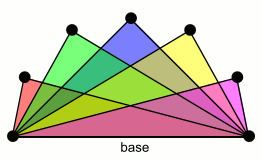 | ||
In graph theory, a book graph (often written
One kind, which may be called a quadrilateral book, consists of p quadrilaterals sharing a common edge (known as the "spine" or "base" of the book). That is, it is a Cartesian product of a star and a single edge. The 7-page book graph of this type provides an example of a graph with no harmonious labeling.
A second type, which might be called a triangular book, is the complete tripartite graph K1,1,p. It is a graph consisting of
Given a graph
The term "book-graph" has been employed for other uses. Barioli used it to mean a graph composed of a number of arbitrary subgraphs having two vertices in common. (Barioli did not write
Theorems on books
Denote the Ramsey number of two (triangular) books by
